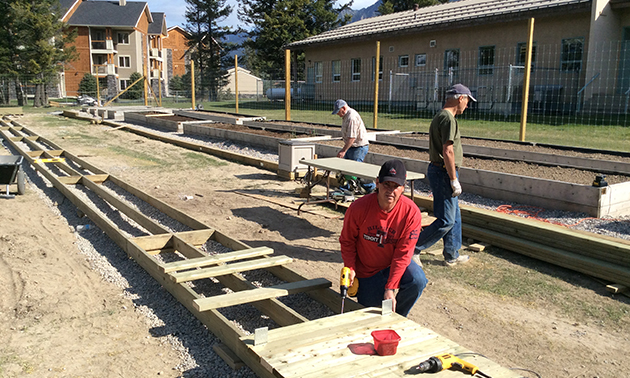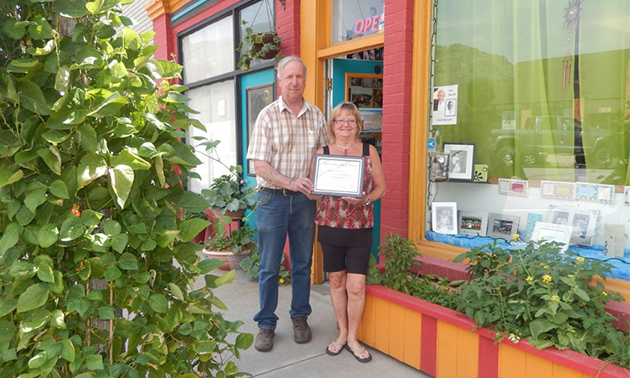Community gardens are greening up the Kootenays
These public gardens produce more than food—they serve up lessons about caring for each other and the Earth

Volunteers build the raised planters for the Rotary Gardens in Radium Hot Springs. — Merilyn Shudra photo
Typically, community gardens are divided into plots for residents to grow their own food. Here are five great examples of Kootenay communities stepping up to the community garden challenge with innovative twists.
New green space in Kaslo
The Village of Kaslo’s website features a great way to get community input with a changing online poll.
Last year, the old fire hall was demolished, which created an opportunity for a new public space beside city hall. The latest poll presented several options for the site. The top three vote getters were a public garden, an outdoor reading area and a piece of art.
The council decided to combine all three ideas. “It wasn’t a detailed survey but council appeared to like the way those options floated to the top,” said Neil Smith, the village administrator.
The project is in the design phase.
Edible gardens in Trail
The primary purpose of the Community Food Bank Garden in Trail is to supply fresh vegetables to the local food banks. Thus, the garden site was established in the Gulch, near Kate’s Kitchen, which is run by the Salvation Army.

Rob Ironmonger of Keystone Appraisals congratulates Darlene Paulson of Doell Photo in Trail for her outstanding edible planters. — Gina Ironmonger photo
The council agreed to the proposal after the Edible Landscape Committee explained that the cost to the city would be minimal. Volunteers will tend the garden, and a neighbour offered use of her time and water to keep the garden growing.
The committee received a grant from Columbia Basin Trust for the planters and materials needed. All planters will be self watering to reduce water waste and save time.
“This garden is a testament to the generous and caring nature of the people who call our community home,” said committee member Gina Ironmonger.
In addition, the IncrEDIBLE Green Route will be expanded this year. This walking route is a unique twist on the community garden concept. Passers-by are invited to harvest edible plants that have been planted and maintained by numerous Trail businesses and service organizations.
Radium Hot Springs' new gardens
Thanks to the vision and leadership of the Sunrise Rotary Club in Radium Hot Springs, the Rotary Gardens will officially open soon. Forty raised beds have been built and all of them are already spoken for by residents who subscribe to use them for the season.
Located in the centre of town, the gardens will include a gazebo, benches, rose bushes and other park-like amenities.
The Rotary club received financial or in-kind support from the Columbia Basin Trust, the Columbia Valley Community Foundation, BC Hydro, Radium Resort and The Springs golf course (which is supplying untreated water).
“We have many people living in condos and apartments, and consequently they just don’t have an opportunity to have their own garden,” said Radium Hot Springs Mayor Clara Reinhardt.
A teaching garden for Grand Forks
Picture a desolate, hard-packed landscape surrounding the Grand Forks Aquatic Centre. In its place now is the Learning Garden, thanks to many volunteers and organizational partners including the city and the regional district.
Over the next three years, the space will be transformed into a garden landscape of raised-bed planters, beekeeping, sheet mulches, water-wise gardening techniques and more. The vision is an educational demonstration garden using permaculture design, which creates resilient human landscapes that mimic patterns and relationships found in nature.
Opening ceremonies and a work party were held on April 10. “We hear every day about the challenges in the world,” said Graham Watt, one of the project leaders. “There are solutions that involve getting your hands dirty, working small and slow at the local level, digging in and working with growing things that help each other out and the Earth.”
Castlegar school's green-up award
Finally, here’s an example of how great greening-up efforts led to a big reward.
After all the mature trees were cut down to make a parking lot, the Kinnaird Elementary School in Castlegar formed a Schoolyard Greening Committee that created a five-year plan. The committee is comprised of students, staff and parents who wrote grants for funding much of the work.
Projects have included creating vegetable garden beds, planting trees and shrubs, building a walking path and being stewards of the wetlands.
The school was rewarded for its environmental efforts with $25,000 worth of technology from Staples Canada in its Annual Superpower Your School Contest. The contest is now in its fifth year and has previously awarded 40 environmentally conscious schools the latest technology to empower students to learn and nurture their passion for the environment.






Comments